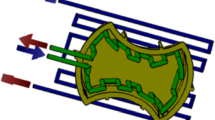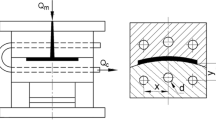Abstract
Cooling system has an important role in the injection molding process in terms of not only productivity and quality, but also mold-making cost. In this paper, a conformal cooling channel with an array of baffles is proposed for obtaining uniform cooling over the entire free-form surface of molded parts. A new algorithm for calculating temperature distribution through molding thickness, mold surface temperature and cooling time was presented. The relation among cooling channels’ configuration, process parameters, mold material, molding thickness and temperature distribution in the mold for a given polymer is expressed by a system of approximate equations. This relation was established by the design of experiment and response surface methodology based on an adequate physical-mathematical model, finite difference method and numerical simulation. By applying this approximate mathematical relation, the optimization process for obtaining target mold temperature, uniform temperature distribution and minimizing the cooling time becomes more effective. Two case studies were carried out to test and validate the proposed method. The results show that present approach improves the cooling performance and facilitates the mold design process in comparison to the trial-and-error simulation-based method.
Similar content being viewed by others
Abbreviations
- α :
-
Thermal diffusivity of polymer (m2/s)
- σ T :
-
Standard deviation of temperature distribution
- d :
-
Diameter of baffle (mm)
- h c :
-
Heat transfer coefficient (W/m2°C)
- k m :
-
Thermal conductivity of mold material (W/m°C)
- k p :
-
Thermal conductivity of polymer (W/m°C)
- q :
-
Instantaneous heat flux (W/m2)
- s :
-
Thickness of molded part (mm)
- t c :
-
Cooling time (s)
- T avg :
-
verage temperature through part’s thickness (°C)
- T e :
-
Ejection temperature (°C)
- T i :
-
Injection temperature (°C)
- T m :
-
Mold temperature (°C)
- T max :
-
Maximum temperature at center line of thickness (°C)
- T ps :
-
Molded part surface temperature (°C)
- T w :
-
Coolant temperature (°C)
- x :
-
The pitch of baffles in x direction (mm)
- y :
-
The pitch of baffles in y direction (mm)
- z :
-
Distance from baffle’s tip to cavity surface (mm)
References
Chiang, H. H., Himasekhar, K., Santhanam, N. and Wang, K. K., “Integrated Simulation of Fluid Flow and Heat Transfer in Injection Molding for the Prediction of Shrinkage and Warpage,” Journal of Engineering Materials and Technology, Vol. 115, No. 1, pp. 37–47, 1993.
Hassan, H., Regnier, N., Le Bot, C. and Defaye, G., “3D study of cooling system effect on the heat transfer during polymer injection molding,” International Journal of Thermal Sciences, Vol. 49, No. 1, pp. 161–169, 2010.
Lam, Y. C., Zhai, L. Y., Tai, K. and Fok, S. C., “An evolutionary approach for cooling system optimization in plastic injection moulding,” International Journal of Production Research, Vol. 42, No. 10, pp. 2047–2061, 2004.
Li, X.-P., Zhao, G.-Q., Guan, Y.-J. and Ma, M.-X., “Optimal design of heating channels for rapid heating cycle injection mold based on response surface and genetic algorithm,” Materials & Design, Vol. 30, No. 10, pp. 4317–4323, 2009.
Lin, J. C., “Optimum cooling system design of a free-form injection mold using an abductive network,” Journal of Materials Processing Technology, Vol. 120, No. 1–3, pp. 226–236, 2002.
Lin, Z.-C. and Chou, M.-H., “Design of the cooling channels in nonrectangular plastic flat injection mold,” Journal of Manufacturing Systems, Vol. 21, No. 3, pp. 167–186, 2002.
Park, S. J. and Kwon, T. H., “Optimal cooling system design for the injection molding process,” Polymer Engineering & Science, Vol. 38, No. 9, pp. 1450–1462, 1998.
Park, S. J. and Kwon, T. H., “Thermal and Design Sensitivity Analyses for Cooling System of Injection Mold, Part 2: Design Sensitivity Analysis,” Journal of Manufacturing Science and Engineering, Vol. 120, No. 2, pp. 296–305, 1998.
Park, S. J. and Kwon, T. H., “Thermal and Design Sensitivity Analyses for Cooling System of Injection Mold, Part 1: Thermal Analysis,” Journal of Manufacturing Science and Engineering, Vol. 120, No. 2, pp. 287–295, 1998.
Qiao, H., “Transient mold cooling analysis using BEM with the time-dependent fundamental solution,” International Communications in Heat and Mass Transfer, Vol. 32, No. 3–4, pp. 315–322, 2005.
Qiao, H., “A systematic computer-aided approach to cooling system optimal design in plastic injection molding,” International Journal of Mechanical Sciences, Vol. 48, No. 4, pp. 430–439, 2006.
Rao, N. S., Schumacher, G., Schott, N. R. and O’brien, K. T., “Optimization of Cooling Systems in Injection Molds by an Easily Applicable Analytical Model,” Journal of Reinforced Plastics and Composites, Vol. 21, No. 5, pp. 451–459, 2002.
Tang, L. Q., Chassapis, C. and Manoochehri, S., “Optimal cooling system design for multi-cavity injection molding,” Finite Elements in Analysis and Design, Vol. 26, No. 3, pp. 229–251, 1997.
Zhou, H., Zhang, Y., Wen, J. and Li, D., “An acceleration method for the BEM-based cooling simulation of injection molding,” Engineering Analysis with Boundary Elements, Vol. 33, No. 8–9, pp. 1022–1030, 2009.
Zhou, H., Li, D. and Cui, S., “Three-dimensional optimum design of the cooling lines of injection moulds based on boundary element design sensitivity analysis,” Proceedings of the Institution of Mechanical Engineers Part B: Journal of Engineering Manufacture, Vol. 216, No. 7, pp. 1067–1071, 2002.
Dimla, D. E., Camilotto, M. and Miani, F., “Design and optimisation of conformal cooling channels in injection moulding tools,” Journal of Materials Processing Technology, Vol. 164–165, pp. 1294–1300, 2005.
Gloinn, T. O., Hayes, C., Hanniffy, P. and Vaugh, K., “FEA simulation of conformal cooling within injection moulds,” International Journal of Manufacturing Research, Vol. 2, No. 2, pp. 162–170, 2007.
Au, K. and Yu, K., “A scaffolding architecture for conformal cooling design in rapid plastic injection moulding,” The International Journal of Advanced Manufacturing Technology, Vol. 34, No. 5, pp. 496–515, 2007.
Ferreira, J. C. and Mateus, A., “Studies of rapid soft tooling with conformal cooling channels for plastic injection moulding,” Journal of Materials Processing Technology, Vol. 142, No. 2, pp. 508–516, 2003.
Park, H. and Pham, N., “Design of conformal cooling channels for an automotive part,” International Journal of Automotive Technology, Vol. 10, No. 1, pp. 87–93, 2009.
Rännar, L. E., Glad, A. and Gustafson, C. G., “Efficient cooling with tool inserts manufactured by electron beam melting,” Rapid Prototyping Journal, Vol. 13, No. 3, pp. 128–135, 2007.
Sachs, E., Wylonis, E., Allen, S., Cima, M. and Guo, H., “Production of injection molding tooling with conformal cooling channels using the three dimensional printing process,” Polymer Engineering & Science, Vol. 40, No. 5, pp. 1232–1247, 2000.
Safullah, A. B. M., Masood, S. H. and Sbarski, I., “Cycle time optimization and part quality improvement using novel cooling channels in plastic injection moulding,” Society of Plastics Engineers, 2009.
Xu, X., Sachs, E. and Allen, S., “The design of conformal cooling channels in injection molding tooling,” Polymer Engineering & Science, Vol. 41, No. 7, pp. 1265–1279, 2001.
Sun, Y., Lee, K. and Nee, A., “The application of U-shape milled grooves for cooling of injection moulds,” Proceedings of the Institution of Mechanical Engineers, Part B: Journal of Engineering Manufacture, Vol. 216, No. 12, pp. 1561–1573, 2002.
Sun, Y. F., Lee, K. S. and Nee, A. Y. C., “Design and FEM analysis of the milled groove insert method for cooling of plastic injection moulds,” The International Journal of Advanced Manufacturing Technology, Vol. 24, No. 9, pp. 715–726, 2004.
Shoemaker, J., “Moldflow design guide: a resource for plastics engineers,” Hanser Verlag, pp. 157–161, 2006.
Menges, G., Michaeli, W. and Mohren, P., “How to make injection molds,” Hanser Gardner Publications, Inc., pp. 316–318, 2001.
Delaunay, D., Bot, P. L., Fulchiron, R., Luye, J. F. and Regnier, G., “Nature of contact between polymer and mold in injection molding. Part I: Influence of a non-perfect thermal contact,” Polymer Engineering & Science, Vol. 40, No. 7, pp. 1682–1691, 2000.
Rosato, D. V., Rosato, D. V. and Rosato, M. G., “Injection molding handbook, 3rd ed.,” Kluwer Academic Publishers, pp. 292–298, 2000.
Bendada, A., Derdouri, A., Lamontagne, M. and Simard, Y., “Analysis of thermal contact resistance between polymer and mold in injection molding,” Applied Thermal Engineering, Vol. 24, No. 14–15, pp. 2029–2040, 2004.
Yu, C. J. and Sunderland, J. E., “Determination of ejection temperature and cooling time in injection molding,” Polymer Engineering and Science, Vol. 32, No. 3, pp. 191–197, 1992.
Farouq, Y., Nicolazo, C., Sarda, A. and Deterre, R., “Temperature measurements in the depth and at the surface of injected thermoplastic parts,” Measurement, Vol. 38, No. 1, pp. 1–14, 2005.
Hioe, Y., Chang, K.-C., Zuyev, K., Bhagavatula, N. and Castro, J. M., “A simplified approach to predict part temperature and minimum ldquosaferdquo cycle time,” Polymer Engineering & Science, Vol. 48, No. 9, pp. 1737–1746, 2008.
Kennedy, P. K., “Practical and scientific Aspects of injection molding simulation,” Doctoral thesis, Materials Technology, Eindhoven University of Technology, 2008.
Nicolazo, C., Sarda, A., Vachot, P., Mousseau, P. and Deterre, R., “Change on temperature at the surface of injection moulded parts,” Journal of Materials Processing Technology, Vol. 210, No. 2, pp. 233–237, 2010.
Zhou, H. and Li, D., “Mold cooling simulation of the pressing process in TV panel production,” Simulation Modelling Practice and Theory, Vol. 13, No. 3, pp. 273–285, 2005.
Hoffmann, K. A. and Chiang, S. T., “Computational fluid dynamics, Volume 1,” Engineering Education System, 2000.
Kazmer, D. O., “Injection mold design engineering,” Hanser Gardner Publications, pp. 203–206, 2007.
Dawson, A., Rides, M., Allen, C. R. G. and Urquhart, J. M., “Polymer-mould interface heat transfer coefficient measurements for polymer processing,” Polymer Testing, Vol. 27, No. 5, pp. 555–565, 2008.
Le Goff, R., Poutot, G., Delaunay, D., Fulchiron, R. and Koscher, E., “Study and modeling of heat transfer during the solidification of semi-crystalline polymers,” International Journal of Heat and Mass Transfer, Vol. 48, No. 25–26, pp. 5417–5430, 2005.
Smith, A. G., Wrobel, L. C., McCalla, B. A., Allan, P. S. and Hornsby, P. R., “A computational model for the cooling phase of injection moulding,” Journal of Materials Processing Technology, Vol. 195, No. 1–3, pp. 305–313, 2008.
Sridhar, L. and Narh, K. A., “Finite size gap effects on the modeling of thermal contact conductance at polymer-mold wall interface in injection molding,” Journal of Applied Polymer Science, Vol. 75, No. 14, pp. 1776–1782, 2000.
Yu, C. J., Sunderland, J. E. and Poli, C., “Thermal contact resistance in injection molding,” Polymer Engineering & Science, Vol. 30, No. 24, pp. 1599–1606, 1990.
AC Technology, “C-MOLD User’s manual,” 1997.
Rao, N. S. and Schumacher, G., “Design formulas for plastics engineers, 2nd ed.,” Hanser Verlag, pp. 51–52, 2004.
Lee, E.-S., Hwang, S.-C., Lee, J.-T. and Won, J.-K., “A study on the characteristic of parameters by the response surface method in final wafer polishing,” Int. J. Precis. Eng. Manuf., Vol. 10, No. 3, pp. 25–30, 2009.
Wang, T.-H. and Young, W.-B., “Study on residual stresses of thin-walled injection molding,” European Polymer Journal, Vol. 41, No. 10, pp. 2511–2517, 2005.
Hassan, H., Regnier, N., Lebot, C., Pujos, C. and Defaye, G., “Effect of cooling system on the polymer temperature and solidification during injection molding,” Applied Thermal Engineering, Vol. 29, No. 8–9, pp. 1786–1791, 2009.
Apple “iSight User’s guide version 9.0,” 2004.
Rao, S. S., “Engineering Optimization: Theory and Practice, 3rd ed.,” Wiley, pp. 477–484, 1996.
Antoniou, A. and Lu, W.-S., “Practical Optimization: Algorithms and Engineering Applications,” Springer, pp. 501–509, 2007.
Michalewicz, Z., “Genetic Algorithms + Data Structures = Evolution Programs, 3rd ed.,” Springer, pp. 33–44, 1996.
Deb, K., “Multi-Objective Optimization Using Evolutionary Algorithms,” Wiley, pp. 81–146, 2001.
Author information
Authors and Affiliations
Corresponding author
Rights and permissions
About this article
Cite this article
Park, HS., Dang, XP. Optimization of conformal cooling channels with array of baffles for plastic injection mold. Int. J. Precis. Eng. Manuf. 11, 879–890 (2010). https://doi.org/10.1007/s12541-010-0107-z
Received:
Accepted:
Published:
Issue Date:
DOI: https://doi.org/10.1007/s12541-010-0107-z




